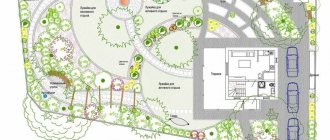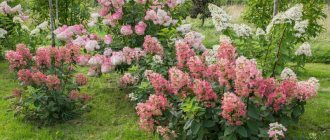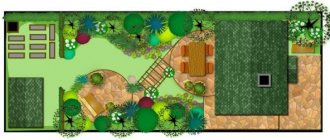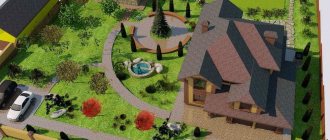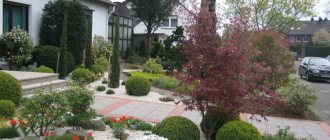How to zone a territory
As with interior design, the design of a small area begins with the development of a similar plan. To do this, the boundaries of the site are drawn on paper to scale. It marks the location of the main building, as well as technical communications that cannot be moved. Here they also indicate the locations of large trees that will remain on the site, and mark the locations of existing auxiliary buildings. Color can be used to highlight those objects that are subject to dismantling or moving in the future.
Landscape design option Source m.yukle.mobi
When developing a plan for the local area, take into account the following:
- First of all, the required number and type of buildings and functional areas on the site are determined. Indicate the location of the main building, outbuildings, vegetable gardens and greenhouses, flower beds, recreation areas with a gazebo, and a children's playground.
- After the main objects on the site have been identified, the places where the garden paths will be located are marked. Conventionally, they can be divided into basic, auxiliary and decorative. The main paths are wider, with a solid covering of tiles or concrete, and smooth. They are designed to connect the main buildings on the site. Such paths should provide the shortest path from the house to auxiliary buildings, for example, to a toilet or bathhouse. The trajectory in this case should be as smooth as possible, without obstacles on the way. Auxiliary paths are located between economic objects on the site: vegetable garden, greenhouse, gazebo and swimming pool. Decorative paths serve as decoration. They can have strange twisting shapes. They are made from stone or tree cuts.
- When placing functional zones on a site, take into account the safe distance between them and the main building. For example, a children's playground should not be located close to a recreation area with a barbecue, and it is also undesirable to place it directly near the bedroom windows in the house. When choosing locations for a vegetable garden or flower garden, take into account the orientation of the site to the cardinal points. To visually make the site look more spacious and free, external buildings should not look massive. It is better to partially hide them behind green plantings in the form of hedges, bushes or other decorative elements.
- The design of a small plot at the design stage involves choosing a design style for the local area. The style can be regular or natural. In the first case, the arrangement of objects and plants is symmetrical, in the second - free. Experts recommend choosing a design in English, rustic or eco style for landscape design of a small area. Minimalism or Japanese style is also suitable.
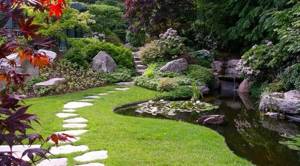
Plot with a pond and Japanese maple Source rehouz.info
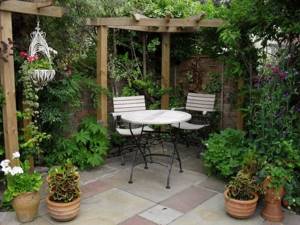
It is advisable to avoid tall, large trees because of their massive root system and spreading crown, which will create a large shady area. It would be better to have one tree under which you can place a cozy seating area.
See also: Catalog of companies that specialize in landscaping work on sites.
Juniper for a small garden
Where thuja grows, as a rule, they cannot do without juniper bushes. It perfectly complements the composition, filling the lower level (if you choose low-growing forms). Junipers vary in shape, height and color. Their crown can be: creeping, spherical, weeping, pyramidal and cone-shaped.
The smallest representatives of junipers grow up to a maximum of 1 m, and the largest tree-like ones - up to 12 m. On average, decorative forms reach a height of no more than 4 m. For small areas it is better to choose the shortest growing junipers. Bushy forms will represent the second and third tiers, and tree-like forms will represent the first. The most common combination is juniper bushes next to columnar or pyramidal thuja.
In addition to being decorative, this plant has medicinal properties - breathing its recognizable aroma is good for health. It purifies the air by producing phytoncides. Inhaling this scent can calm your nerves and even normalize your sleep. Once upon a time, in ancient times, juniper smoke was even used to fumigate homes, protecting them during epidemics.
Juniper, like thuja, is an evergreen plant. By combining it with other conifers, you can create timeless compositions that will delight you all year round. For example, a rock garden that does not require a lot of time and plants. For small areas, different varieties of junipers such as Cossack, Virginia, Siberian, common, Chinese, rocky and scaly are suitable. They are distinguished by excellent winter hardiness and decorative properties.
In general, junipers are unpretentious plants that can grow in different lighting conditions and in any soil. But on fertile lands they feel and look better (which has a positive effect on their decorative properties). On loamy soils, before planting juniper, you need to make drainage from small stones or broken red bricks - this will avoid stagnation of water. The latter is especially true for places where groundwater passes close to the surface of the earth.

Options for arranging a small area
When starting to design the area around the house, large objects are first placed on it so that they do not look massive. To do this, plants and hedges are planted between them, and vertical gardening elements are installed.
Attention! When designing the area around the house, the requirements of fire sanitary standards are taken into account. They establish rules regarding indentations from the border of the site, from buildings located in the neighboring territory, and technical structures.
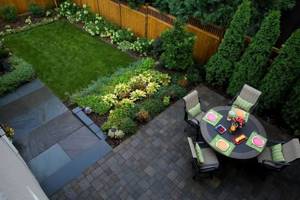
If the area of the territory is sufficient, the house is located in its depth. This allows you to visually expand the site by creating a small area with a lawn and flower beds in front of the house. You will definitely have to provide a place to park your car.
The location of the garage depends on the number of floors of the house. If it is two-story, then the garage is located on the ground floor and is insulated. If the house is one-story, then the garage is located on the side.

Arrangement of the backyard Source www.pinterest.cl
When starting to develop a project for a local area, even if it is small, it is advisable to take into account its geological parameters. In particular, it is important to have an idea of the properties of the soil, since this criterion will be decisive when choosing plant species and the design style of the site.
For a comfortable recreation area on the territory, choose the most remote, quiet and windless place. There is also a barbecue area here.
Sedums for a small garden
Since we have already mentioned rocky gardens many times, which can take up very little space, we cannot remain silent about sedum plants. This is a special group of plants that, in addition to the usual planting in the ground, are used in other areas of design. For example, in frame topiary and vertical gardening. Sedums are extremely diverse in appearance, shape and color.
How do sedums stand out among other ornamental crops?
- Outwardly, they are unlike anything else. For the most part, these are small and miniature plants, usually with fleshy and succulent leaves, which are called succulents. A minority of plants from the sedum group can reach 40-70 cm in height and have relatively large inflorescences. But they retain an important difference between the group - succulent stems and leaves.
- Small sedums tend to grow and spread, forming carpets (i.e. without gaps). Such plants can fill empty spaces in small compositions and rocky gardens. The larger ones also grow densely, forming dense bushes.
- Almost all sedums are undemanding or low-demanding to the soil, drought-resistant and sun-loving. And this is not surprising, because their natural habitat is mountains. That is why they have succulent, fleshy leaves (which may resemble cacti), in which they store moisture.
Sedums have the scientific name sedum. They do not like waterlogging, but respond well to feeding. The latter increase the decorative qualities of sedums, promoting flowering and increasing leaf mass. A small garden is the perfect place for these plants. With their help, you can even create miniature corners that will captivate with their charm.
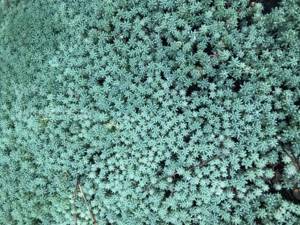
The role of trees in a small area
When choosing a design for a small area, take into account the presence of existing plants. You should not place a large number of tall trees with a spreading crown in a small area. It is better to place one or two large deciduous trees that will provide the necessary coolness and shade on hot days. This is an ideal place to create a recreation area. A large tree will also help disguise an unsightly view, hide from prying eyes, and reduce lighting in the bedroom, the windows of which overlook the garden.

Decorating a small area with a high fence Source lv.aviarydecor.com
Coniferous trees and shrubs are especially popular. They are unpretentious and thrive in conditions of limited sunlight. When choosing a place to plant a tall tree, you need to find out in advance how it will shade the area.
With the help of a large tree, you can also close off neighbors, decorate an undesirable view, or shade a terrace or bedroom windows.
Roses for a small garden
Roses are flowers that are always beyond competition. They are capable of fabulously transforming the place where they grow. No good garden is complete without roses. Therefore, if you have not planted them yet, do so urgently. Just be prepared for the fact that any rose requires full care (which is not surprising for the queen of flowers).
Shrub roses
Shrub forms of roses come in different heights and widths. For small gardens where space is limited, small ones are more suitable. Where you need to make an accent and there is room for it, you can plant your favorite variety from the floribunda group. These are rich-looking roses that produce abundant and long-lasting blooms (some almost continuously).
Hybrid tea roses, honored veterans of floriculture and landscape design, are also distinguished by their long flowering time. They are not so tall, and, accordingly, take up less space on the site.

Standard roses
These are special representatives of roses, speaking about the highest level of landscape design, real splendor. Standard roses look like trees with a spherical or hanging crown, strewn with delightful flowers. They can be placed singly or on one line, for example, along an alley. They require special pruning, fertilizing, protection from pests/diseases and timely watering.
To decorate a small area, a small number of standard roses is enough. Even one rose tree, skillfully placed in the garden, can become the “highlight of the program” and a magnificent accent from which you will not want to take your eyes off. Roses on a standard can be made from floribunda or climbing roses, choosing your favorite varieties.
climbing roses
These beauties are designed to decorate arches, pergolas, fences and trellises. There is always a place for all this in a small area. They are able to decorate quite large spaces, creating a heavenly atmosphere. If you want to be in a good mood during the warm season in any weather, be sure to plant climbing roses in your garden. Yes, they require periodic maintenance, but it's worth it.
Some of the most popular varieties of such roses are Raubritter, Eva, Ducat, Bouquet Parfait, Handel, Tahikan Moon, Cyrano de Bergerac, Florentina and High Hops.

Ground cover roses
They are just as beautiful as other varieties of roses. A beautiful carpet of flowers, which is formed by ground cover roses, can cover any free area - from the border between the lawn and the path to a low fence or part of a rock garden. They bloom profusely and almost continuously and strengthen the soil, preventing it from being washed away by rain (which is important on slopes). In a small garden, such roses can also find a suitable place.
The main characteristic of ground cover roses is the width of the bush - it is always significantly greater than the height. In addition, such plants are characterized by accelerated shoot growth. Thanks to this, they quickly cover a fairly large area of land. The advantages of such roses include easier care - they do not need to be cut or shaped. Among the varieties of ground cover roses, we note the following: Scarlet, Matador, Drift, Amber sun, Red Leonardo, Fairy, Hallow, Super Dorothy, Amber carpet and Gartenfreude.
Pond on the site
The surface of the water, like a mirror, has a reflective ability, so it visually increases the space around. A pond in a small area primarily provides an opportunity to divert attention from the area of the territory. A small well-kept pond will become the main accent and decoration of the site. But it is better to refuse a fountain or an artificial waterfall, since in a small area the sound from the continuous murmur of water will create discomfort.

Pond on site Source yandex.ru
You can decorate the pond with water lilies, decorative stones and garden figurines in the form of birds or frogs.
Choosing a place for a gazebo
The main advantage of a country house with an adjacent territory is that it can accommodate a comfortable and cozy recreation area with a gazebo, where you can relax in any weather.
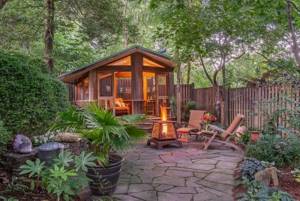
Gazebo with fire Source dcmdva-apld.org
When designing a recreation area, take into account the following:
- If the area is too small, then you don’t have to install a gazebo, but limit yourself to a light canopy with climbing plants and a bench.
- In a small flat clearing in the summer, under the spreading branches of a tree, it is enough to place wicker furniture: a table and a couple of armchairs.
- All kinds of prefabricated structures with awnings in the form of canopies and tents are available for sale. Temporary gazebos reliably protect from sun, wind, rain and mosquitoes.
- To locate a stationary gazebo, choose a hill or a place remote from the main building. The manufacturing material can be wood, metal or polycarbonate. They are usually used in combined gazebos, where the metal frame is sheathed with wood or polycarbonate. To make the gazebo look light, it is made as open as possible, without walls, with openwork details that let in light.
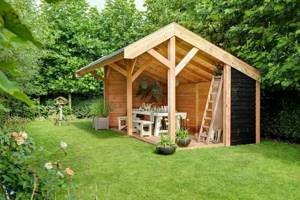
Next to the gazebo there is a barbecue area. A flat, compacted area is suitable for this. Sometimes it is covered with tiles or stone. In some cases, barbecue areas become the main accent on the territory, and flower beds and flower beds serve as their decoration and are located around them.
Annuals for a small garden
The group of annuals is very large. This includes a variety of annual flowers that can be used to fill mixborders and flowerpots or pots, highlight paths and decorate various compositions. Annuals have always been, are and will be. They are an integral part of most gardens, including the smallest ones. There is no point in listing such plants here or giving any examples. You can easily find a wide range of these colors in various online and offline stores. When choosing annuals, consider color compatibility, layering, flowering time and requirements for external conditions. It’s good if you can choose flowers that will allow some to bloom when others have already faded. This is one of the principles of successful creation of flower beds and mixborders.
Brightly flowering annuals in a small garden can be placed in flowerpots or pots (including hanging ones). Be sure to plant them on your site - then the summer season will give you maximum impressions. In order to feel happy, all you need is a small garden and a great desire to create beauty with your own hands. Are you ready to make it a reality?
Join our Facebook group
The role of the lawn
In a small area, it is necessary to provide space for a lawn. You can decorate it with shrubs, pebbles or paving slabs. A lawn can serve not only as decoration, but also as a convenient place for active games.
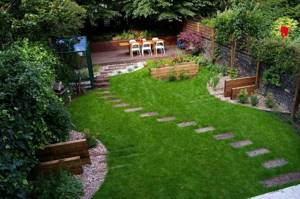
Decorative path Source biscle.com/
It is recommended to place the lawn in a visible area of the site, preferably in front of the house. This is one of the techniques for visually increasing space when the flat surface of the lawn is framed by shrubs and ornamental plants around the perimeter.
Designers do not recommend placing massive buildings and plantings in the central part of the garden, but rather, setting aside this space for a flat area with short grass.

Landscaping of a small area in front of the house Source m.yukle.mobi
In a small area, the lawn also performs a communication function, allowing you to move around the area without overloading it with a large number of garden paths. For this purpose, trampling-resistant grasses are planted.
Hosta for a small garden
If you have shaded areas of land, plant a hosta plant there. She feels great in the shade, delighting with her unique decorativeness. She is even called the queen of decorative leaf crops. Yes, this plant is valuable for its leaves, which can be of different shades and color combinations.
In the sun, the hosta also, as they say, “blooms and smells.” By the way, she can live in one place for up to 30 years. This is one of the most unpretentious plants of all ornamental representatives. In addition, it can be combined with anything - wherever you plant it, it will be in place everywhere. In general, hosta is a kind of “universal soldier” of landscape design. Perhaps no one else has such a combination of external beauty and incredible unpretentiousness.
There is always a place for hosta in a small garden - its size allows it to be planted even in miniature flower beds. By the way, it is used in most mixborders - it perfectly complements flowering plants. Hosta is also magnificent next to conifers. Or as part of rocky gardens and even in pots.
The second name of the hosta, which is little known, is functionia (not to be confused with function). If you meet him, know what culture he is talking about.
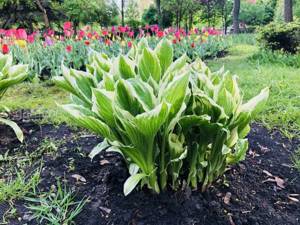
Construction of an alpine slide
If there is a natural unevenness on the site, you can arrange a decorative element such as an alpine slide. It not only looks beautiful, but also attracts attention, becoming the main decoration of the area around the house.

Rock garden on the site Source yandex.ru
The work plan for the arrangement of the alpine hill is developed at the site planning stage. You will need large stones, perennial plants, and coniferous shrubs.
If there is no fertile soil on the site, you can use sandy or rocky soil, which is suitable for good development and flowering of plants.
The simplest and most popular type of alpine slide is a rocky cliff. This method of arrangement is especially relevant for areas with a natural steep slope. When creating such a rock garden, large boulders are first laid and then plants are planted.

Rockery in front of the house Source bg.aviarydecor.com
To diversify the composition, large blocks are dug into the ground, creating paths that imitate a mountain landscape. And plants of different colors allow you to add realism.
You should not give up the idea of arranging a rock garden if the area near the house does not have natural slopes. It is enough to correctly arrange stones of different sizes and plant plants.
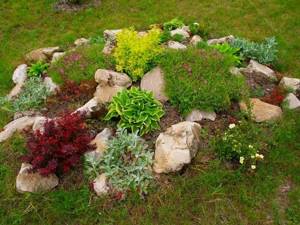
Small alpine slide - decoration of the site Source stroimdom21.ru
On a flat area, you can arrange a flat rock garden with several high points in the form of large stones, trees or shrubs. Decorative gravel is poured into the space between these elements or creeping ground cover plants are planted. Such a rock garden will take up little space, and it is better to place it along the front part of the site near the recreation area with a gazebo.
Another variety is called a gravel garden. To create it, gravel is poured and steppe plants are planted. In this case, large boulders are not used.
Groundcover perennials for a small garden
Ground cover ornamental plants most often include flowering perennials. Not a single beautiful garden can do without them. Whether it’s a flowerbed, rockery, mixborder or pots, ground cover perennials can be harmoniously placed everywhere. One of the most popular options is to simulate spilling liquid from an overturned jug. These are the flowers that are used in such compositions. In addition, with their help you can create frame topiaries, frame steps on both sides, decorate tree trunks, fill small empty spaces and do much more, for which your imagination is enough.
The most prominent representatives of ground cover perennials include:
- Saxifraga is a charming plant that definitely needs to be planted in a small garden (it is very suitable for a composition with a jug);
- periwinkle is also a magnificent ornamental plant, often used in landscape design;
- Jaskolka is a sun-loving perennial that, in addition to flowers, is decorative with its bluish stem and leaves;
- obrietta is a very densely flowering perennial that forms a carpet of flowers (loves moisture, sun and does not tolerate transplants);
- Arabis is a small drought-resistant miracle with a wide range of different shades of flowers and emerald leaves;
- Iberis is a fragrant ground cover that has both vertical and creeping shoots;
- Alyssum is a plant with flowers of various colors that can bloom for a very long time if faded inflorescences are removed in time.
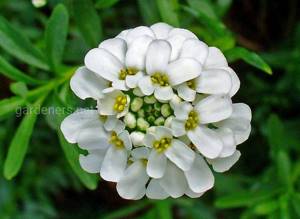
What a garden can be like
A garden is not necessarily something large-scale, with a lot of trees and shrubs. Even in a small area you can correctly arrange plants.
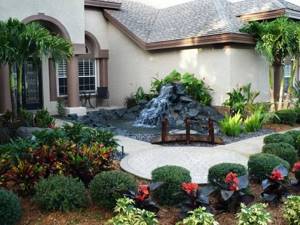
Waterfall near the house Source yandex.by
When arranging a small garden, you should follow a few simple rules:
- When planting plants, their light requirements are taken into account. Thus, the tallest plants are planted in the northern territory, and the shortest ones, on the contrary, are planted in the southern part of the site.
- It is advisable that plants that are used for a small garden do not take up much free space. Particular attention should be paid to the design of the entrance to the site. To arrange flower beds and flower beds, use the space along the fence, and in the center of the site create a decorative composition with bright lush flowers.
- The place for the garden is chosen last. If desired, place compact beds between flower beds and flower beds.
Spruce, pine and fir for a small garden
These are three more representatives of evergreens, which are suitable both for rockeries or rock gardens, and for mixed compositions or solitaires. In small areas you need to plant low-growing and dwarf forms. They are quite diverse in their appearance and height. Among them there are spherical, creeping, conical, pyramidal and even the so-called cushion-shaped varieties. The advantages of low-growing forms include ease of care, undemanding pruning or frequent watering/feeding, slow growth and long life.
Spruce
The spruce plant has excellent decorative characteristics. Its short form does not grow very tall and therefore does not take up much space. In modern landscape design, a number of varieties and forms of decorative spruce trees are used, which feel great in different climatic zones. Among them, Nidiformis is not a tree, but a tiny shrub that grows to only 40 cm in 10 years. Its shape is called nest-like and is perfect for rocky gardens.
Another dwarf representative of spruce is Little Gem, which is not far from the previous one. It has a hemispherical shape and grows up to half a meter in height. In addition to rock gardens, such trees look good in flowerpots. The Glauka Globoza spruce looks very beautiful. It already looks much more like a Christmas tree than the first two varieties. This small, compact and lush miracle of blue-gray color has a wide conical shape. Glauka Globoza is suitable for a wide variety of compositions and single plantings in a small garden.
Another popular variety is Konika spruce. From the name it follows that the shape of the tree crown is conical. It is also called pyramidal. Konika belongs to the Canadian spruce tree and is highly decorative. Green, fluffy and finely needle-shaped, it is immediately recognizable. If you have seen her at least once, you probably fell in love with this coniferous beauty. Konica's maximum height is 4 m. She can reach it in 60 years.
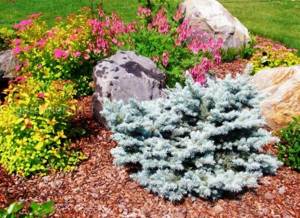
Pine
Dwarf pine does not reach large sizes and grows very slowly. That is, even if your plot is miniature, this will not prevent you from planting a real pine tree on it. It is unpretentious in care, like other conifers, and is also frost-resistant and drought-resistant. The beauty of ornamental pines is in their rich splendor, which is formed due to long needles. They look best in single plantings, when other plants do not distract attention from their beauty. An excellent option for placing dwarf pines are rocky gardens.
The most common of the decorative representatives is the dwarf mountain pine. There are a number of magnificent varieties that differ in appearance, but are united by one important property - compact size. These varieties include spherical Mugus, creeping Pumilio, round and wide-pyramidal Gnome, cushion-shaped Pug and spherical golden Winter Gold.

Fir
Fir is a very ornamental plant, which in nature is represented by tall trees. But the breeders took care of the landscape designers and developed dwarf forms that can be planted in a small garden. By the way, among the small representatives of this genus there is one naturally dwarf one. This is Korean fir Diamond. It is considered a rarity, which is why it is highly valued by landscape design connoisseurs. It is often used in Japanese gardens - examples of impeccability, beauty and harmony.
Low-growing firs can be spherical, cushion-shaped, dome-shaped and conical. They are quite drought-resistant, winter-hardy and unpretentious. They like sun or partial shade. Fir varieties suitable for small gardens include Brilliant, Oberon, Molly, Silberlock, Nana and others.
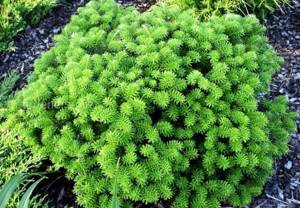
Techniques for visually increasing space
There are various design techniques that can reduce the impression of cramped space through the correct approach to the design of objects located on the site. It’s worth starting with a fence - a fencing structure around the perimeter of the territory. It not only indicates the boundaries of the site, but also protects the garden from wind, dust, animals and strangers from the street.
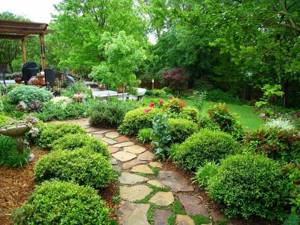
Stone path Source www.pinterest.ca
The height of the fence is regulated by regulations and requires its manufacture from materials that are 50% light-transmitting. From an aesthetic point of view, a blank and high fence attracts all attention and visually makes the space smaller than it actually is.
If you cannot do without such a fence, then it should be camouflaged with the help of climbing plants and trees (grapes, ivy, roses, lemongrass), thanks to which the living wall will become a continuation of the garden. In other cases, it is better to abandon massive structures in favor of lightweight ones with high light transmittance.

Landscape design in English style Source roomester.ru
A wooden fence looks best, it can even be solid - natural wood does not cause discomfort, but on the contrary, it will give a feeling of comfort and warmth. Other popular designs include picket fences or trellises. Such a fence can also be partially camouflaged with climbing plants.
You can also visually adjust the area of the local area using decorative elements and buildings. Several original techniques can be distinguished:
- Some functional areas on the site can be raised by creating an artificial height difference. For example, a garden area with a rock garden and flower beds can be raised by 20 cm. This will make it look larger than the areas located next door. 2. A blind fence is replaced with a metal mesh, picket fence or hedge, thereby expanding the boundaries of the site. A greater effect can be achieved by changing the height and width of the fence. 3. The perception of the area of a site largely depends on the shape of the objects located on it. A sculpture, flower arrangement or any other decorative element that is round or spherical in shape will create the illusion of space. 4. Paths going into perspective also create the impression of infinity of space. Such paths have a winding shape and, going around walls with climbing plants, decorative arches or flower beds, seem to run into the distance. 5. It is worth paying attention to the shades of flowering plants. If you plant light flowers in the corners of the area, the area will visually expand. 6. You should get rid of empty corners, which visually significantly limit the space. To fill them, use corner flower beds, benches, gazebos or garden figurines.
- A blank fence is replaced with a metal mesh, picket fence or hedge, thereby expanding the boundaries of the site. A greater effect can be achieved by changing the height and width of the fence.
- The perception of the area of a site largely depends on the shape of the objects located on it. A sculpture, flower arrangement or any other decorative element that is round or spherical in shape will create the illusion of space.
- Paths going into perspective also create the impression of infinity of space. Such paths have a winding shape and, going around walls with climbing plants, decorative arches or flower beds, seem to run into the distance.
- It is worth paying attention to the shades of flowering plants. If you plant light flowers in the corners of the area, the area will visually expand.
- You should get rid of empty corners, which visually significantly limit the space. To fill them, use corner flower beds, benches, gazebos or garden figurines.
Several decorative compositions in different places in the form of flowers or decor will attract attention to themselves, and not to the area of the site.
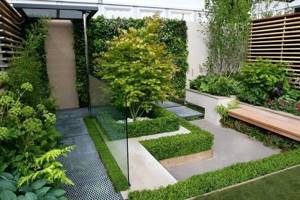
Art Nouveau style in landscape design Source www.pinterest.com
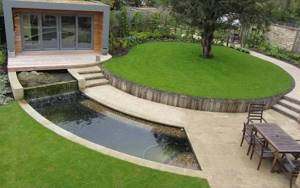
Reservoir on the site Source landshaft-spb.ru
Thuja for a small garden
Thuja is a universal plant that is suitable for any site. In addition to its excellent decorative properties, its main advantage is that it is evergreen. Thuja will delight the eye and warm the soul even in late autumn and winter, when, due to the cold and monotony of natural colors, many are covered with a wave of melancholy and apathy. If you organize even a miniature “living corner” with evergreens in your garden, such problems will probably not affect you.
With the help of thuja, you can decorate the entrance area or small alleys, create hedges or small compositions, place accents or simply place single plantings. Thanks to its undeniable advantages, thuja has become an integral part of modern landscape design. And this is not surprising, because, among other things, it can be cut at almost any time of the year, giving the crown the desired shape (both in a hedge and in compositions or tapeworms). Thuja has a so-called topiary crown.
Thuja occidentalis
Thuja occidentalis is a general name that includes many different varieties and forms that differ in a number of ways. The homeland of this species is North America, where it grows naturally. Decorative thujas bred by breeders have different shapes, colors, heights and growth rates. This diversity allows you to select varieties to suit every taste and create wonderful compositions with them.
Thuja occidentalis is the most popular species in the CIS. It tolerates winters well, lives a long time, is easy to care for and is resistant to dust/smoke/gas, which is simply invaluable in urban environments. It can be used to create hedges that not only perform a decorative and barrier function, but also protect against exhaust gases entering the area. Thuja releases a large amount of phytoncides and spreads a very pleasant aroma, which becomes brighter after sprinkling (watering from above with a spray stream).
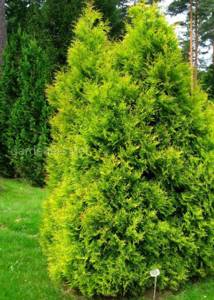
The following varieties of thuja are suitable for a small area:
- Smaragd - grows to about 4 m (although the network says that up to 2.5 m). This variety has a beautiful color of needles, which is why it got its name (smaragd - means emerald). The shape of these thujas is also very successful - columnar-pyramidal (in adulthood, ovoid). They look great in compositions, hedges and solitaires. Perhaps this is the most beloved and most versatile variety, which simple gardeners most often use in landscape design. It is very decorative - it has beautiful thick needles.
- Columna is a variety that looks more like a column. During their life, trees grow to approximately 8 m. They grow less in width, so to form a hedge they require more frequent planting in a row. Such thujas also have a very decorative appearance.
- Danica is a dwarf spherical beauty that is perfect for compositions in a small garden. Its dense, bright green crown can survive without shearing - the ball shape in this variety is genetically determined. Due to its decorative properties, Danica is considered the most popular spherical variety. It grows up to 60 cm in height.
- Teddy - also has the shape of a ball and belongs to the dwarf varieties. Its needles are smaller, so they seem soft and airy. The name Teddy is very suitable for this variety, because the plants are somewhat reminiscent of soft plush toys.
In addition to those already described, the following varieties are suitable for small areas: Gold Smaragd, Globoza, Sunkist and Golden Globe.
Arbor vitae
Oriental thuja is also actively used in landscape design. It differs in its region of origin (its homeland is China and Japan), external characteristics and some biological features. The lush oriental thuja (or thuja thuja) looks very decorative (one might even say delightful), so it is deservedly loved by many modern designers. It is often used to decorate rocky gardens; it is used in small compositions and placed singly (in the form of a tapeworm). The flat branch is characterized by a certain versatility - it loves the sun, but can grow normally in the shade, which is a very valuable quality for small gardens. True, in the spring this plant is afraid of the bright sun, which becomes more active after winter, and may suffer from burns. This means that for the oriental thuja it is still better to choose partial shade (especially in the southern regions). Or in early spring it needs to be protected from sunlight.
Oriental thuja is characterized by drought resistance. It withstands long-term absence of rain and watering, which is very convenient to care for. However, its drought resistance is not without the “other side of the coin” - the flat branch does not tolerate stagnation of water in the soil. In the southern regions this practically does not happen, but in the middle zone and more northern latitudes it can occur at different times of the year (for example, in the first half of spring).
But this quality does not exclude the possibility of planting thuja eastern in the middle zone. The solution to the problem is the mandatory arrangement of drainage during planting and cultivation on lighter soils that do not retain moisture. In the southern regions, the soils should be heavier - fertile loamy. They are able to retain moisture better than light soils, which is an advantage in conditions of frequent droughts. Thuja orientalis is considered a rather heat-loving plant, so it is not recommended for planting in the northern regions.


